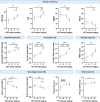Pilot implementation of the revised criteria for staging of Alzheimer's disease by the Alzheimer's Association Workgroup in a tertiary memory clinic
- PMID: 39287564
- PMCID: PMC11567817
- DOI: 10.1002/alz.14245
Pilot implementation of the revised criteria for staging of Alzheimer's disease by the Alzheimer's Association Workgroup in a tertiary memory clinic
Abstract
Introduction: We aimed to evaluate the feasibility of the 2024 Alzheimer's Association Workgroup's integrated clinical-biological staging scheme in outpatient settings within a tertiary memory clinic.
Methods: The 2018 syndromal cognitive staging system, coupled with a binary biomarker classification, was implemented for 236 outpatients with cognitive concerns. The 2024 numeric clinical staging framework, incorporating biomarker staging, was specifically applied to 154 individuals within the Alzheimer's disease (AD) continuum.
Results: The 2024 staging scheme accurately classified 95.5% AD. Among these, 56.5% exhibited concordant clinical and biological stages (canonical), 34.7% demonstrated more advanced clinical stages than biologically expected (susceptible), and 8.8% displayed the inverse pattern (resilient). The susceptible group was characterized by a higher burden of neurodegeneration and inflammation than anticipated from tau, whereas the resilient group showed the opposite.
Discussion: The 2024 staging scheme is generally feasible. A discrepancy between clinical and biological stages is relatively frequent among symptomatic patients with AD.
Highlights: The 2024 AA staging scheme is generally feasible in a tertiary memory clinic. A discrepancy between clinical and biological stages is relatively frequent in AD. The mismatch may be influenced by a non-specific pathological process involved in AD. Individual profiles like aging and lifestyles may contribute to such a mismatch. Matched and mismatched cases converge toward similar clinical outcomes.
Keywords: Alzheimer's disease; amyloid; clinical‐biological staging scheme; inflammation; neurodegeneration; positron emission tomography; tau.
© 2024 The Author(s). Alzheimer's & Dementia published by Wiley Periodicals LLC on behalf of Alzheimer's Association.
Conflict of interest statement
Tzu‐Chen Yen is an employee of APRINOIA Therapeutics Co., Ltd. (Suzhou, China). All other authors have no conflicts of interest to declare. Author disclosures are available in the supporting information.
Figures





Similar articles
-
Revised criteria for diagnosis and staging of Alzheimer's disease: Alzheimer's Association Workgroup.Alzheimers Dement. 2024 Aug;20(8):5143-5169. doi: 10.1002/alz.13859. Epub 2024 Jun 27. Alzheimers Dement. 2024. PMID: 38934362 Free PMC article.
-
NIA-AA Research Framework: Toward a biological definition of Alzheimer's disease.Alzheimers Dement. 2018 Apr;14(4):535-562. doi: 10.1016/j.jalz.2018.02.018. Alzheimers Dement. 2018. PMID: 29653606 Free PMC article. Review.
-
Application of the NIA-AA Research Framework: Towards a Biological Definition of Alzheimer's Disease Using Cerebrospinal Fluid Biomarkers in the AIBL Study.J Prev Alzheimers Dis. 2019;6(4):248-255. doi: 10.14283/jpad.2019.25. J Prev Alzheimers Dis. 2019. PMID: 31686097
-
Non-beta-amyloid/tau cerebrospinal fluid markers inform staging and progression in Alzheimer's disease.Alzheimers Res Ther. 2018 Sep 25;10(1):98. doi: 10.1186/s13195-018-0426-3. Alzheimers Res Ther. 2018. PMID: 30253800 Free PMC article.
-
[The new 2011 recommendations of the National Institute on Aging and the Alzheimer's Association on diagnostic guidelines for Alzheimer's disease: Preclinal stages, mild cognitive impairment, and dementia].Rev Neurol (Paris). 2012 Jun;168(6-7):471-82. doi: 10.1016/j.neurol.2011.11.007. Epub 2012 May 12. Rev Neurol (Paris). 2012. PMID: 22579080 Review. French.
Cited by
-
Role of 18F-florzolotau PET in diagnostic and therapeutic decision-making for cognitive impairment.Alzheimers Dement. 2025 Aug;21(8):e70563. doi: 10.1002/alz.70563. Alzheimers Dement. 2025. PMID: 40819956 Free PMC article.
-
Clinical features, biomarker profiles, and neuroimaging characteristics in patients from memory clinic in china: The Shanghai Memory Study.Alzheimers Dement. 2025 Jun;21(6):e70378. doi: 10.1002/alz.70378. Alzheimers Dement. 2025. PMID: 40566759 Free PMC article.
References
-
- Therriault J, Schindler SE, Salvadó G, et al. Biomarker‐based staging of Alzheimer disease: rationale and clinical applications. Nat Rev Neurol. 2024;20:232‐244. - PubMed
-
- Ding D, Zhao Q, Guo Q, et al. Prevalence of mild cognitive impairment in an urban community in China: a cross‐sectional analysis of the Shanghai Aging Study. Alzheimer's Dement. 2015;11:300‐309. - PubMed
MeSH terms
Substances
Grants and funding
LinkOut - more resources
Full Text Sources
Medical

